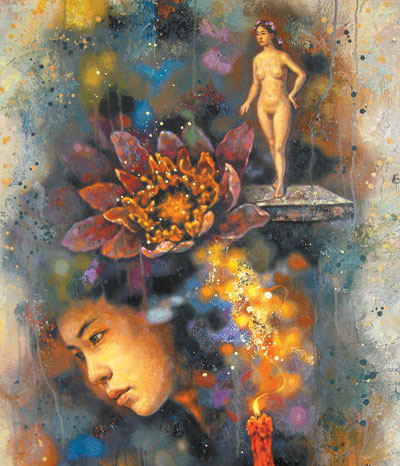|

Anna Zhao
anna.whizh@yahoo.com
THE Dragon Year Gallery in Futian District is showcasing a number of Chinese contemporary artworks that capture the younger generation’s emotions and thoughts about life in modern China, in styles and images much different from those of more accomplished artists.
Founded in 2012, the gallery operates like an art salon, frequently inviting artists and designers to share their ideas. This latest exhibition features works by rising artists who recently graduated from top art academies in China.
Gallery founder Tsai Will and his partner went across half of China to visit eight top academies and meet with hundreds of young artists in person. In the end, seven artists’ works were initially selected to be presented.
The young artists, long taught perspectives grounded in China’s rich and traditional art background, are struggling to integrate traditional Chinese art into their contemporary expressions.
An oil-on-canvas painting, titled “In the Rainy Season,” by Zhao Kaijin from the Xi’an Academy of Fine Arts, for example, achieves the effect of watercolor painting. The use of a brush on flat canvas creates a bleeding effect with the author’s sensitive use of color.
Several oil-on-paper paintings, by Yu Zhongwen from Lu Xun Academy of Fine Arts, grouped together and using traditional Chinese painting paper as their medium, create a foggy scene of dusk with the use of intersecting lines that seem to be randomly drawn.
Somber styles
The somberness of solitary figures is a universal theme across artworks from different schools.
Such paintings are often dominated by lonely individuals who are thinking or reflecting. The artists very often choose dark colors, rather than vibrant prints of greens or yellows, which is considered a trend with artists now in their 30s.
An oil-on-canvas painting titled “Breaking Dreams” by Li Liang from the Central Academy of Fine Arts, depicts a boy thinking against a background of floral images. The picture, involving a certain degree of surrealism by using foggy images that are not focused, evokes traditional Chinese abstractness.
A group of paintings of human faces by Wang Min, from the South China Normal University, features thought-provoking depictions of women with abnormal eyes, somewhat like dragons’ eyes. The eyes send a somber signal that none of the protagonists are happy, though they are not necessarily sad. The author also demonstrates very mature brush techniques, as not a single brush stroke can be observed even at close range. Wang’s work looks like she’s drawing on paper, even though she’s actually painting.
Growing attraction
Tsai said there have been breakthroughs with Chinese mainland artists in recent years and the world is increasingly attracted to Chinese art.
“Many art galleries in Hong Kong are selling contemporary artworks that were created a decade ago by artists who are now in their 30s or older. These artists are prone to use bright colors and cartoon images,” Tsai said. “The paintings we are bringing up are more reflective of what’s going on in China at present.”
Tsai and his partner said there is tremendous potential with the art market in Shenzhen, where many people import art from Hong Kong at huge costs. They said works by young Chinese artists are creating a much different genre from works sold in Hong Kong.
“China is changing with its Five-Year Plan, and so does its art. Shenzhen will realize it’s not Hong Kong’s neighbor and will attain its own identity in either economic or art development,” Tsai said.
He said young artists are trying to sort out what exactly is contemporary Chinese art and attempting to integrate their traditional backgrounds into contemporary expressions.
Tsai and his partner said they’ve been encouraged to find that these artists are expressing their feelings about China through independent, artistic eyes and are not influenced by foreign art. “What’s really wonderful is that the artists are thinking about what kind of country they are building, what kind of direction they are going in, and how they are contributing to Chinese society,” they said.
|

